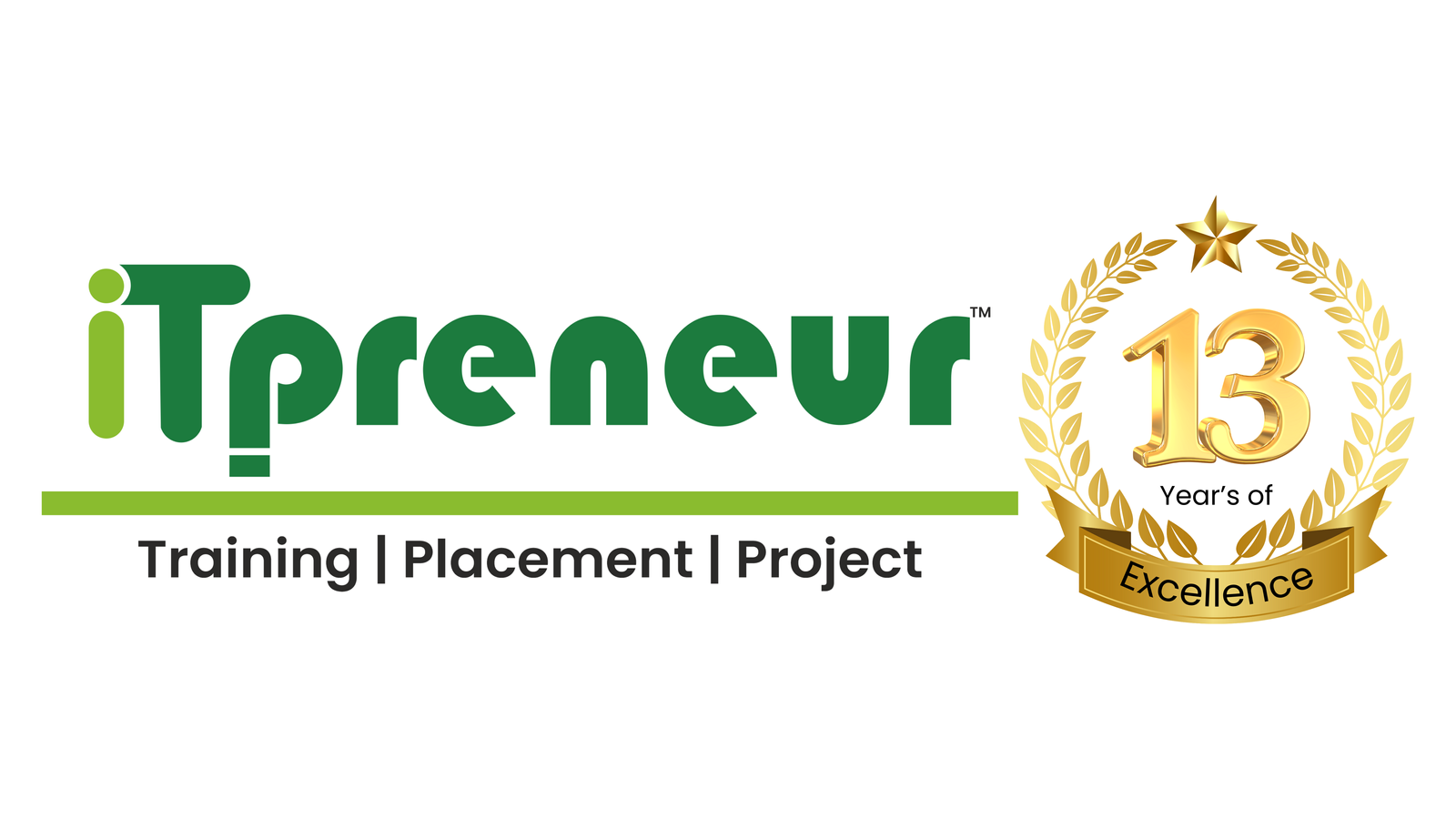Why Full-Stack Development Is Your Ticket to ₹5 LPA+

In today’s hyper-digital world, where every company is turning tech-first, one role stands tall in demand and pay: the Full-Stack Developer. If you’re looking to earn ₹5 LPA or more right out of your training or within your first IT job, Full-Stack Development might just be your golden ticket. Here’s why: 1. Dual Power: Frontend + Backend Skills Full-stack developers are experts in both the frontend (user interface) and backend (server/database) of web applications. This dual capability makes them incredibly valuable. Employers love this versatility—why hire two developers when one can do both? 2. High Demand = High Pay Companies today are looking for developers who can handle complete projects end-to-end. That means full-stack developers are in high demand across startups, MNCs, and product-based companies. With the right skill set and internships or projects, ₹5 LPA is absolutely within reach. 3. Job Security & Career Flexibility Whether it’s building a mobile app, a website, or a complete SaaS platform, full-stack developers fit into multiple roles: This flexibility ensures you’re always employable—even during slow markets. 4. Startups Love Full-Stack Talent Startups want agile teams and multitasking employees. A full-stack developer can manage multiple layers of a project, reducing dependency and speeding up delivery. Startups also offer higher equity or faster growth opportunities compared to traditional MNCs. This can boost your long-term income exponentially. 5. Freelance & Side Hustle Friendly Don’t want to do a 9 to 5 job? No problem. Full-stack developers are in huge demand on freelance platforms: Clients across the globe hire full-stack developers for websites, e-commerce platforms, SaaS MVPs, and more. You can earn in dollars while sitting at home. 6. Fast Learning, Quick Earning With structured training (like ITpreneur’s Full Stack Development Program), you can: Even if you’re from a non-IT background, this role is learnable and pays off quickly. 7. You Become a Problem Solver Full-stack isn’t just about knowing languages. It’s about thinking like a developer: This problem-solving mindset makes you an asset in any company. 8. Placement Success Stories At ITpreneur, dozens of students have landed roles with packages starting from ₹4 to ₹7 LPA within months of completing their Full Stack program. “I never thought I could earn over 5 LPA coming from a non-technical background. But the Full Stack course changed everything.” – Ankit J., Placed at MNC Final Thoughts The Full Stack Developer role isn’t just a job title — it’s a career superpower. With a versatile skill set, the ability to work across domains, and explosive market demand, ₹5 LPA+ is not a dream. It’s a milestone waiting for you to achieve. So whether you’re a fresher, a working professional, or someone from a non-IT background, now is the time to go full-stack and future-proof your career. Ready to build your career? Join the Full Stack Development Program at ITpreneur, JM Road, Pune. Visit: www.itpreneurpune.comContact: 8237002020 / 8087423030
How Java Full Stack Skills Land You a ₹7 LPA Job in 6 Months

In a competitive job market, it’s nice to have a solid technical skill but learning Java Full Stack Development is a game changer. With the right training and practice, we have had students land jobs from ₹4.5 LPA to even ₹7 LPA, some in just 6 months of learning. Let’s see how. What Is Java Full Stack? Java Full Stack Development means that you have been trained to work on the user interface (front-end) and the server-side (back-end) of a web application. A Full Stack developer works with: Core + Advanced Java Spring Boot for APIs HTML, CSS, JavaScript, React for front-end MySQL or MongoDB for databases Version control using Git & GitHub If you’re successful in mastering all of these subjects, you will be a complete software developer—a developer who can independently develop an entire web application. Why Are Java Full Stack Developers in High Demand You Save Time & Money Companies would rather hire one full stack developer instead of two developers for the front-end and back-end. Java Is Long Lasting Java is used in the banking application segment, enterprise software segment and Android applications. When you connect Java with the frameworks like Spring Boot, you have a powerful toolset. Great Salaries Even junior users with strong Java Full Stack skills get hired, with salaries from ₹4.5 LPA to ₹7 LPA. Your 6-Month Journey to Learning At ITpreneur Pune, we train students in a step-by-step format to prepare and make students ready for work in 6 months: Month 1–2: Core Java + Front-End Basic Java (OOPs, collections, loops) HTML, CSS, JavaScript, Bootstrap Git basics Month 3–4: Advanced Java + Database JDBC, MySQL Servlet, JSP Spring Boot and REST APIs Month 5: React + API Connection React.js (Hooks, Props, State) Connecting Java with React Month 6: Projects + Placements. Real mini & major projects, new true world projects Resume prep, mock interviews DSA & aptitude training Skills that Companies Want Here are the skills which most of our students develop: Dynamic web development using Java, Spring Boot & React Secure APIs that connect to Front-end Build projects using tools such as GitHub, VS Code, etc Real life projects, real life problems Examples of Success Stories At ITpreneur Pune, students from commerce, arts, and even non-IT degrees are getting jobs in companies such as: Infosys Wipro Cognizant Zensar Mphasis Product-based start-ups in Pune, Bangalore & Hyderabad. How? We provide a justified course roadmap with lots of practice, excellent mentorship, and consistent placement attempts. Why ITpreneur Pune? Trainers dedicated to Full Stack Java development Real live project practical experience Mock interviews + soft skills Guarantee placements support Industry recognised certification. We don’t only teach – you build, practice, and grow with us. What Recruiters are SayingMost recruiters today are looking for developers that can: Complete the full development life-cyle Think logically & debug issues Communicate effectively with teams That is why we designed our training as we did. What You Need to Get Started?If you are looking to change your career, or you are just getting started, starting fresh as a beginner is the best opportunity to start in the IT industry. All you need is consistency, phyisical or cognitive mentorship; and set a solid routine practice. Please visit our Blog to find out more information and student reviews of our IT Bootcamps: itpreneurpune.com/blog The Final WordJava Full Stack is not just a buzzword – it truly is a career maker. Having the knowledge in Full Stack Development gives you opportunities in the IT industry like: Full Stack Developer Java Developer Software Engineer Backend Engineer With guidance and commitmet you can go from a noob to a ₹7 LPA job in just 6 months. Are you ready to take the leap of faith? Join us at ITpreneur Pune.
Digital Marketing Course in 2025: Key Skills You Need to Master

OverviewTraditional billboards have given way to Instagram reels, Google Ads, and email campaigns in today’s fast-paced digital world. The need for qualified digital marketers is greater than ever as 2025 approaches. Companies are looking for people who can develop high-converting strategies, use tools to expand online, and comprehend the digital landscape. Knowing the essential abilities that will make you stand out is essential if you intend to enrol in a digital marketing course in 2025. We’ll go over the key digital marketing competencies that all aspiring professionals should possess in this blog, along with how attending ITpreneur Pune can help you stay on top of trends.
Building Scalable Web Applications: Full Stack Best Practices

Building Scalable Web Applications: Full Stack Best Practices Introduction In the era of cloud computing, millions of users access web applications every second. Whether it’s shopping, learning, or banking — users expect web applications to run smoothly, securely, and without delays. But with great growth comes a great challenge: scalability. So, how do you build a web application that’s not just functional but also ready to grow with your business? The answer lies in full stack best practices that ensure your application can handle more traffic, data, and complexity as time goes on. What is Scalability in Web Applications? Scalability refers to an application’s ability to handle increasing loads without compromising performance. Whether you’re growing from 100 users to 10,000 or adding new features and functionalities, a scalable app can support that growth smoothly. There are two main types of scalability: vertical scaling, which involves adding more power (CPU, RAM) to a single server, and horizontal scaling, which means adding more servers or systems to handle increased traffic. Choosing the Right Tech Stack The foundation of any scalable web app is the tech stack — the combination of front-end, back-end, database, and server technologies. A modern full stack often includes frontend frameworks like React, Angular, or Vue.js; backend technologies such as Node.js, Express, Django, or Spring Boot; databases like PostgreSQL, MongoDB, or MySQL; and cloud platforms such as AWS, Heroku, Vercel, or GCP. Choosing the right combination based on your project’s needs ensures performance, flexibility, and easier scaling. Component-Based Architecture Front-end frameworks like React and Vue support component-based development, allowing developers to break down the user interface into small, reusable parts. This modular approach makes the codebase more organized and maintainable, eases the process of debugging and testing, and simplifies the addition of new features. On the back end, structuring your app using service-based modules — such as user management, billing, and notifications — supports horizontal scaling and smoother updates. Optimizing APIs for Performance APIs are the bridge between your front end and back end. To make your app scalable, you should avoid sending unnecessary data in responses, use pagination to limit large data loads, implement rate limiting to protect against abuse, and design versioned APIs to allow smoother updates. These practices reduce server strain and improve user experience. Efficient Database Management As your user base and data grow, database optimization becomes essential. Choosing the right database type is crucial — use relational databases like MySQL or PostgreSQL for structured data and NoSQL databases like MongoDB for flexible data models. Efficient indexing of frequently queried columns, avoiding overfetching data, and storing large media files in cloud storage like AWS S3 instead of the database can significantly boost performance and scalability. Secure & Scalable Authentication Security and scalability must go hand-in-hand. Stateless authentication using JSON Web Tokens (JWT) and third-party logins with OAuth 2.0 (e.g., Google or Facebook) are recommended. Passwords should always be stored securely using hashing techniques like bcrypt, and your site should always run on HTTPS. These methods help protect user data while keeping the system responsive even under high user loads. Caching for Speed & Scalability Caching helps serve users faster by storing frequently accessed data. You can cache static assets like JavaScript, CSS, and images using Content Delivery Networks (CDNs) such as Cloudflare. Backend responses can be cached using tools like Redis or Memcached. Similarly, frequently run database queries can be cached to reduce load and response time, ensuring a better user experience. Testing, Monitoring, and Debugging Scalable applications need to be reliable. Regular testing ensures that your features continue to work even as your user base grows. Use unit testing for individual functions or components, integration testing to see how modules work together, and end-to-end testing to simulate real user scenarios. Monitoring tools like Google Analytics for user behavior, Sentry or LogRocket for error tracking, and New Relic or Datadog for performance monitoring help you catch issues early and maintain system stability. Continuous Integration & Deployment (CI/CD) CI/CD pipelines allow developers to automatically test, build, and deploy code with every change. Tools like GitHub Actions, Jenkins, or GitLab CI streamline the development workflow, allowing teams to catch bugs early and deploy new features more quickly and reliably. This is crucial for maintaining a scalable and agile development process. Use Cloud Services & Load Balancers Hosting your application on cloud platforms like AWS, GCP, or Azure allows for auto-scaling, meaning your app can automatically adjust its resources based on current traffic. Load balancers distribute traffic across multiple servers, helping prevent overload on a single machine and ensuring consistent performance. Conclusion Building a web application is easy. But building one that can grow to serve millions of users without crashing or slowing down takes planning, structure, and discipline. By following full stack best practices — from choosing the right tech stack to structuring your application for scalability, optimizing APIs, and implementing CI/CD — you can create robust, scalable web applications ready for the future.
Why Soft Skills Will Define Success in 2025

Why Soft Skills Will Define Success in 2025 In today’s fast-paced, technology-driven world, technical knowledge is crucial — but it’s no longer enough. As we approach 2025, soft skills are becoming the true game-changers for personal and professional success. Companies are no longer just looking for candidates who can code or analyze data; they want individuals who can communicate, adapt, collaborate, and lead effectively. Let’s dive deeper into why soft skills are going to define success in 2025 and how you can start mastering them today. What Are Soft Skills? Soft skills refer to non-technical skills that impact how you interact with others and manage your work. They include: While technical (or “hard”) skills can often be taught through training, soft skills are more about personality, mindset, and interpersonal effectiveness. Why Soft Skills Are Gaining Importance 1. The Rise of Remote and Hybrid Work With remote and hybrid work becoming the new norm, clear communication and collaboration are more important than ever. When teams are scattered across different locations, it’s critical to manage time effectively, show empathy, and resolve conflicts smoothly. Soft skills help bridge the physical distance and maintain strong, connected teams. 2. Automation and AI Are Taking Over Routine Tasks As artificial intelligence and automation continue to advance, many routine tasks are being handled by machines. What remains are roles that require human touch — critical thinking, creativity, leadership, and emotional intelligence. These are all areas where soft skills shine and where humans will always have the edge over machines. 3. Leadership Roles Require More Than Just Expertise Tomorrow’s leaders are not just experts; they are motivators, problem-solvers, and visionaries. Managing a team requires active listening, motivating others, resolving conflicts, and adapting to change — all soft skills. Companies are increasingly promoting individuals who demonstrate strong leadership abilities, not just technical know-how. 4. Customers Expect Personalization and Empathy In 2025, customer service is not just about delivering a product or service — it’s about offering a personalized, empathetic experience. Companies are realizing that to build loyal customers, they need employees who can connect emotionally and build trust. Soft skills play a major role in creating these lasting relationships. Top Soft Skills You Should Focus On for 2025 Communication Skills Whether it’s writing an email, giving a presentation, or participating in a meeting, clear and effective communication is essential. Listening actively and expressing your ideas clearly can make you stand out in any field. Emotional Intelligence Emotional intelligence (EQ) is the ability to understand and manage your emotions, and those of others. High EQ helps you handle stress, make better decisions, and create stronger workplace relationships. Adaptability Change is the only constant. Being open to new challenges, technologies, and ways of working will keep you relevant and resilient in the evolving workplace. Critical Thinking and Problem Solving Employers value individuals who can think critically, analyze information, and come up with creative solutions to problems. It’s about being proactive, not just reactive. Leadership and Teamwork Even if you are not in a management role, leadership skills like inspiring others, taking initiative, and collaborating effectively are highly valued across all industries. How to Develop Your Soft Skills You might wonder, “Can soft skills really be learned?” The answer is yes! Here are some ways to start building them: Final Thoughts In the coming years, the definition of success will shift. Having top technical skills will still matter, but what will truly set individuals apart is their mastery of soft skills. Being able to communicate, lead, empathize, and adapt will not only help you grow in your career but also make you an invaluable asset to any organization. At iTpreneur, we recognize this change and emphasize building soft skills alongside technical expertise, ensuring our students are truly ready for real-world success. Start working on your soft skills today — because in 2025, they will define your success!
React vs. Angular: Dispelling the Differences for Developers

React vs. Angular: Dispelling the Differences for DevelopersIn web development, React and Angular are two of the most widely used front-end frameworks among developers to create modern, dynamic, and user-friendly web applications. Whether you’re beginning your career as a developer or researching frameworks for your next project, knowing the difference between React and Angular is crucial. This blog deconstructs the major differences, strengths, and best use cases for each. What Are React and Angular?React is a JavaScript library built by Facebook. It is mostly utilized for constructing user interfaces, particularly single-page applications. It’s component-based, meaning you construct bits of a web app and then assemble them like building blocks. Angular is an entire front-end framework from Google. As opposed to React, which is limited to the view layer, Angular provides a whole development suite to construct intricate apps right off the shelf. Ease of LearningReact: Developers often find React easier to learn because it focuses only on the user interface part. If you’re familiar with JavaScript, picking up React becomes much simpler. Its flexible nature allows developers to choose the tools and libraries they prefer. Angular: Angular has a steeper learning curve. It supports TypeScript (a JavaScript superset), and comes with more built-in functionality. It may intimidate newbies at first, but it’s incredibly powerful once learned. Flexibility vs. StructureReact: It’s famous for being flexible, and React permits developers to use additional tools and libraries when necessary. This allows you to tailor your dev stack to suit the project’s needs. Angular: Provides a structured and opinionated way. Everything you require is already in there, which can be a good thing for big teams or enterprise projects. But it provides less room for customization. PerformanceReact and Angular both provide high performance for the majority of use cases. But: React employs a technique known as virtual DOM, making it quick and efficient to update the UI. It only re-renders parts of the page that change. Angular uses real DOM and two-way data binding, meaning it changes the model and the view simultaneously. This is a bit slower in extremely large applications but not visible in small to medium-sized apps. Community and SupportReact: With a huge community of developers and support from Meta (Facebook), React has hundreds of tutorials, third-party libraries, and frequent updates. Therefore, finding the solutions and study materials is more convenient. Angular: Backed by Google, Angular also enjoys strong community support, especially among enterprise-level developers. The documentation is thorough, but fewer third-party libraries are available compared to React. Ideal Use CasesChoose React if: You want to build a lightweight, high-performance app You prefer a flexible tech stack You’re working on a project that needs frequent updates and component reuse Choose Angular if: You’re developing a large-scale enterprise application You want a complete solution with all tools included You’re comfortable with TypeScript and structured frameworks Career OpportunitiesBoth React and Angular are in high demand in the job market. However: React is more common in startups and mid-size companies due to its simplicity and adaptability. Angular is widely used in large enterprises and government projects that require scalable and maintainable solutions. Final ThoughtsReact and Angular both provide heavy-hitting solutions for front-end development. Picking the better one depends on what your project needs, what you’re used to with JavaScript/TypeScript, and what amount of structure or flexibility you need. As a beginner, React may be the better entry point because of its ease of use. When it comes to big, heavy projects, though, Angular’s a more thorough solution. Whichever you select, both frameworks will provide you with useful skills and lead to interesting opportunities in the technology industry.
The Importance of Career Counseling: How It Can Shape Your Future

The Importance of Career Counseling: How It Can Shape Your Future Choosing the right career is one of the most important decisions a person will make in their life. However, in today’s fast-paced world, students and even working professionals often find themselves confused, overwhelmed, or misdirected when it comes to career planning. That’s where career counseling plays a vital role. This blog explores the importance of career counseling, how it works, and why it can positively shape your future. What Is Career Counseling? Career counseling is a structured process that helps individuals understand their abilities, interests, values, and personality, and guides them toward a suitable career path. It is conducted by professional career counselors who are trained to evaluate educational and professional backgrounds and help clients set realistic career goals. Why Career Counseling Is Important 1. Clears Confusion Many students are unsure about what to pursue after 10th or 12th grade. With hundreds of career options available today, it’s easy to get confused. Career counselors help narrow down the choices based on personal strengths and interests, making the decision clearer. 2. Discover Hidden Strengths and Interests Through psychometric tests and one-on-one discussions, a career counselor can help identify hidden talents, potential, and interests that might have gone unnoticed. This helps in selecting a career that not only suits the individual but also keeps them motivated. 3. Saves Time and Money Choosing the wrong course or career path can lead to wasted years and financial loss. Career counseling helps avoid such mistakes by guiding students and professionals in the right direction from the beginning. 4. Helps Set Realistic Goals Career counseling encourages individuals to set short-term and long-term goals. These goals are based on their skills, the job market, and personal aspirations, leading to better planning and execution. 5. Understanding the Job Market A good career counselor provides updated information about various industries, future trends, emerging careers, and job demands. This market knowledge is essential for making smart career decisions. How Career Counseling Shapes Your Future Career counseling is not just about choosing a job. It plays a major role in long-term career satisfaction and success. Here’s how: 1. Provides Clarity and Direction With guidance, students and professionals gain clarity on what suits them best, both personally and professionally. This direction eliminates guesswork and builds confidence in the career path chosen. 2. Improves Decision-Making Skills By understanding oneself better through counseling, individuals learn how to make informed decisions. This not only helps in choosing a career but also in future transitions and advancements. 3. Encourages Skill Development Once a career path is chosen, counselors often recommend courses, certifications, or skills required to succeed in that field. This ensures individuals are well-prepared for their desired roles. 4. Reduces Career-Related Stress Career-related anxiety and pressure from peers or parents are common. Career counseling provides a neutral space where individuals can discuss their doubts freely and get unbiased advice, reducing stress. 5. Supports Career Transitions Even working professionals benefit from career counseling, especially if they’re planning a job switch, moving to a new field, or re-entering the workforce after a break. Counselors help in identifying transferable skills and building a strategy for the transition. When Should You Seek Career Counseling? You can seek career counseling at any stage, but it’s especially useful: What to Expect in a Career Counseling Session A typical session may include: Final Thoughts In a world full of opportunities and ever-changing job landscapes, career counseling acts as a guiding light. It empowers individuals to make thoughtful, informed, and confident decisions about their future. Whether you’re a student unsure about what to do next or a professional stuck in an unsatisfying job, career counseling can be the turning point in your journey. Remember, choosing a career is not just about a job — it’s about building a future you’ll enjoy and grow in. Need help planning your career? Reach out to professional counselors at trusted institutions or career platforms and take the first step toward shaping a future you’ll be proud of.
How React.js Simplifies Frontend Development: A Complete Overview

How React.js Simplifies Frontend Development: A Complete Overview In the ever-evolving world of web development, creating efficient, interactive, and scalable user interfaces has become a top priority. React.js, developed by Facebook, has emerged as one of the most popular JavaScript libraries that simplifies frontend development. It enables developers to build dynamic web applications with better performance and improved user experience. Whether you’re a beginner in web development or someone exploring modern technologies, understanding how React.js works and why it’s preferred can help you make smarter tech choices. In this blog, we’ll break down how React.js simplifies frontend development, its key benefits, and why it’s an industry favorite. What is React.js? React.js is an open-source JavaScript library used for building user interfaces, particularly for single-page applications. It allows developers to create reusable UI components that can be easily managed and updated, making it easier to build complex applications with minimal code. Key Features That Simplify Development 1. Component-Based Architecture One of the main reasons React.js is loved by developers is its component-based structure. Instead of building an entire UI in one go, you can break it down into smaller, manageable pieces called components. Each component handles a specific part of the interface and can be reused throughout the application. This modular approach not only saves development time but also makes the code easier to maintain and test. 2. Virtual DOM for Better Performance React uses a concept called the Virtual DOM (Document Object Model). Instead of reloading the entire page every time a change is made, React updates only the parts of the page that need to change. This leads to faster rendering and a smoother user experience. This smart updating process is one of the key reasons why applications built with React feel fast and responsive. 3. Reusability and Scalability With React, developers can build components once and reuse them across different parts of the application or even in other projects. This reduces redundancy and helps in maintaining consistent UI across the app. It also makes scaling the application easier, as you can keep adding new features without rewriting existing code. 4. Easy to Learn and Use React has a gentle learning curve compared to other frontend frameworks. If you have basic knowledge of JavaScript, HTML, and CSS, you can start working with React fairly quickly. Its syntax (JSX) allows you to write HTML-like code in JavaScript, which makes it easier to design components visually. 5. Strong Community and Ecosystem React has a large and active community, which means you’ll always find support, tutorials, tools, and third-party libraries to help you during development. Whether you’re debugging an issue or looking for better practices, chances are someone in the community has already solved it. Benefits of Using React.js in Frontend Development 1. Faster Development Process With reusable components, real-time updates through the Virtual DOM, and a rich ecosystem, React makes development faster and more efficient. Developers can focus more on building features instead of worrying about how to structure the UI from scratch. 2. Improved User Experience React’s real-time rendering and fast loading times significantly improve user experience. Since only the parts that need updating are refreshed, the app feels seamless and responsive to user interactions. 3. Better Code Management React promotes writing clean, well-organized code. Components are kept separate, which means developers can work on different parts of the application without affecting each other’s code. 4. Flexibility and Compatibility React can be easily integrated into existing projects. Whether you’re building a new application from scratch or adding interactive features to a current site, React can fit in without major changes. 5. Great for Mobile Development Too React Native, based on React.js, allows developers to build mobile applications for iOS and Android using the same principles. This opens up cross-platform development without learning a completely new language. Why React.js Is a Top Choice for Developers React isn’t just popular because it’s easy—it’s popular because it solves real problems. Startups, enterprises, and tech giants alike rely on React for its speed, efficiency, and maintainability. Big names like Facebook, Instagram, Airbnb, Netflix, and Uber use React to power their web interfaces. For developers, it means learning a skill that is in high demand across the job market. Conclusion React.js has transformed the way frontend development is approached. From its component-based architecture to its performance-boosting features like the Virtual DOM, React simplifies the development process while delivering high-quality results. Whether you’re a beginner developer or a professional looking to expand your skillset, learning React is a smart investment in your career. It not only simplifies building beautiful and dynamic user interfaces but also opens the door to exciting job opportunities and projects. So, if you’re still wondering whether React.js is the right choice—it absolutely is.
Top SQL Commands Every Developer Should Know

Top SQL Commands Every Developer Should Know In today’s data-driven world, SQL (Structured Query Language) is one of the most essential tools for software developers, data analysts, and IT professionals. Whether you’re working in backend development, building dashboards, or analyzing large datasets, understanding SQL is a must. But with so many commands available, where should a beginner start? This blog highlights the top SQL commands every developer should know, explained in simple, non-technical language. If you’re just starting your SQL journey or want to refresh the basics, this guide is for you. What is SQL? SQL stands for Structured Query Language. It is the standard language used to interact with databases. You can think of SQL as the way to “talk” to a database — you can ask it questions, add or remove information, and make changes to the data stored inside. Why is SQL Important? Before diving into the commands, here’s why SQL is a must-learn skill: Now let’s look at the top SQL commands that every developer should know. 1. SELECT This is one of the most used commands in SQL. It allows you to view data stored in a database. If you want to check or analyze specific information like a customer’s name or a product’s price, this is the command you’ll use. Purpose: Fetch data from a database table. 2. INSERT This command lets you add new data into a table. For example, when a new user signs up on a website, SQL is used to insert their details into the database. Purpose: Add new records to a table. 3. UPDATE Need to change some information in the database? The UPDATE command helps you modify existing data. For instance, if a user changes their phone number, the system uses this command to update their contact information. Purpose: Modify existing records. 4. DELETE This command removes data from the database. It’s useful for cleaning up outdated or incorrect information. Purpose: Remove one or more records from a table. 5. CREATE TABLE Databases store information in tables. When you want to build a new table to store data (like for users, products, or orders), you use the CREATE TABLE command. Purpose: Define a new table in the database. 6. DROP TABLE This command is the opposite of CREATE TABLE. If you no longer need a table, this command will completely remove it along with all the data inside it. Purpose: Permanently delete a table from the database. 7. ALTER TABLE Sometimes, you might need to make changes to an existing table — like adding a new column or renaming one. ALTER TABLE helps with these adjustments. Purpose: Modify the structure of an existing table. 8. WHERE This is not a command by itself but is used along with SELECT, UPDATE, or DELETE to specify conditions. For example, you might want to delete only those records where the user hasn’t logged in for 6 months. Purpose: Filter data based on specific criteria. 9. JOIN Databases often store related information in different tables. JOIN lets you bring this information together. For example, you can connect a table of users with their orders to see who bought what. Purpose: Combine data from multiple tables. 10. GROUP BY This command is useful when you want to organize data into categories. For instance, if you want to know the number of orders per customer, GROUP BY can help summarize this data. Purpose: Organize and summarize data based on specific columns. 11. ORDER BY Want to see the highest-paying customers first or list products by price? ORDER BY lets you sort data in ascending or descending order. Purpose: Sort the results of a query. 12. LIMIT When working with large datasets, it’s often helpful to view only a small portion of the data. LIMIT restricts the number of records returned, making the data easier to manage and review. Purpose: Control the number of records displayed. Final Thoughts SQL may seem intimidating at first, but learning these basic commands will give you a strong foundation to work with databases. Whether you’re managing a user list, generating reports, or tracking sales, these commands help you get the job done efficiently. By mastering these essential SQL commands, you’ll become a more confident and capable developer — ready to handle real-world data challenges with ease. Quick Recap Here’s a quick checklist of must-know SQL commands: Bookmark this guide, and refer to it as you practice SQL. And remember — the more you use SQL, the more natural it becomes.
Data Analytics vs. Data Science: Skills, Tools, and Career Prospects

Data Analytics vs. Data Science: Skills, Tools, and Career Prospects In the digital age, data is the new oil, and understanding how to harness its power has become essential. Two of the most popular and rapidly growing fields in this data-driven world are Data Analytics and Data Science. While they may sound similar and share some overlap, they serve different purposes, require distinct skill sets, and offer varied career opportunities. This blog aims to provide a comprehensive comparison between the two, diving into their core differences, required skills, tools, and career prospects. What is Data Analytics? Data Analytics focuses on interpreting existing data to uncover actionable insights. It involves analyzing datasets to identify trends, patterns, and relationships that can help organizations make informed decisions. Key Objectives of Data Analytics: What is Data Science? Data Science is a broader field that combines data analytics, machine learning, artificial intelligence, and programming to build predictive and prescriptive models. It not only interprets historical data but also forecasts future outcomes and drives automation. Key Objectives of Data Science: Skills Required Data Analytics Skills: Data Science Skills: Tools Used Popular Tools for Data Analytics: Popular Tools for Data Science: Career Opportunities Career Roles in Data Analytics: Average Salary (India): INR 4–8 LPAAverage Salary (US): $60,000–$85,000 per annum Career Roles in Data Science: Average Salary (India): INR 8–20 LPAAverage Salary (US): $95,000–$130,000 per annum Which One Should You Choose? Choosing between Data Analytics and Data Science depends on your interests and career goals: Also, Data Analytics can often serve as a stepping stone to Data Science. Many professionals start their careers as analysts before transitioning into data science roles with more experience and training. Future Outlook Both fields are in high demand and continue to grow as organizations seek to become more data-driven: With businesses prioritizing data-driven strategies, professionals in both domains can expect a bright future with numerous opportunities for growth. Conclusion While Data Analytics and Data Science share a foundation in working with data, they diverge in approach, scope, and application. Data Analytics is about interpreting and visualizing past data, while Data Science is about creating models that predict and automate the future. No matter which path you choose, gaining proficiency in working with data will open doors to lucrative and fulfilling careers. Start with your interests, explore real-world applications, and continuously upgrade your skills to stay relevant in this ever-evolving domain.

